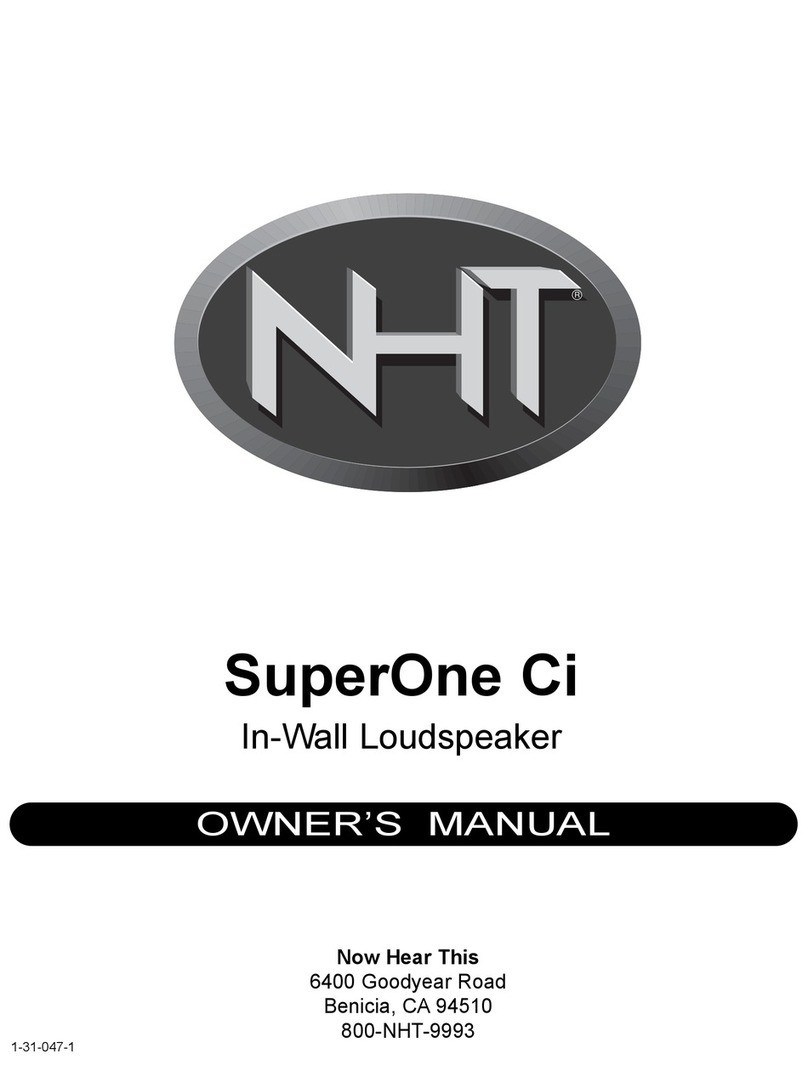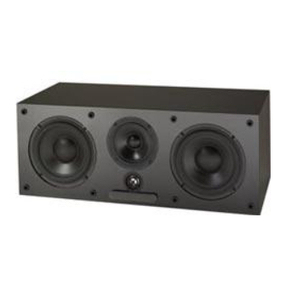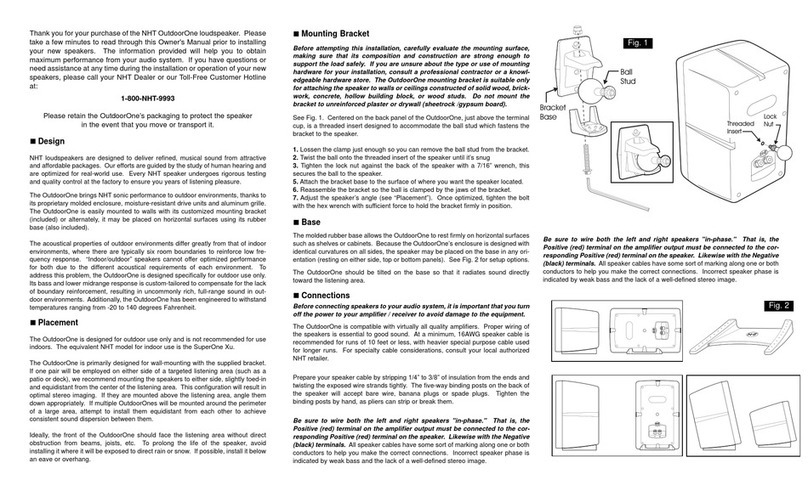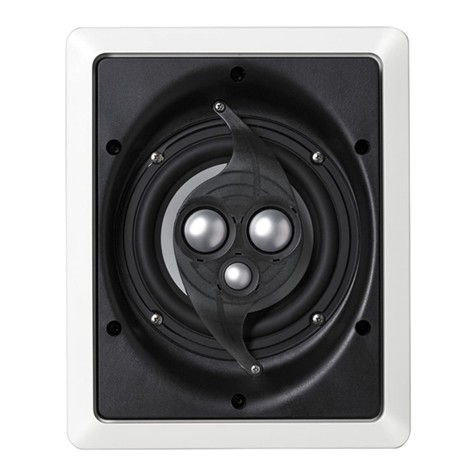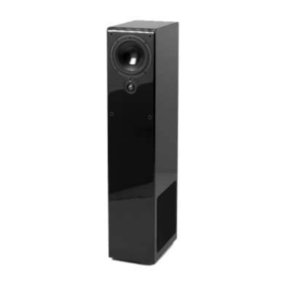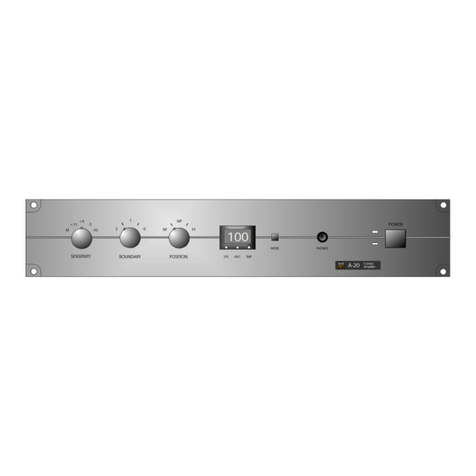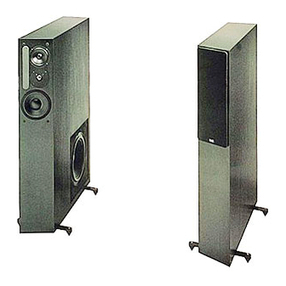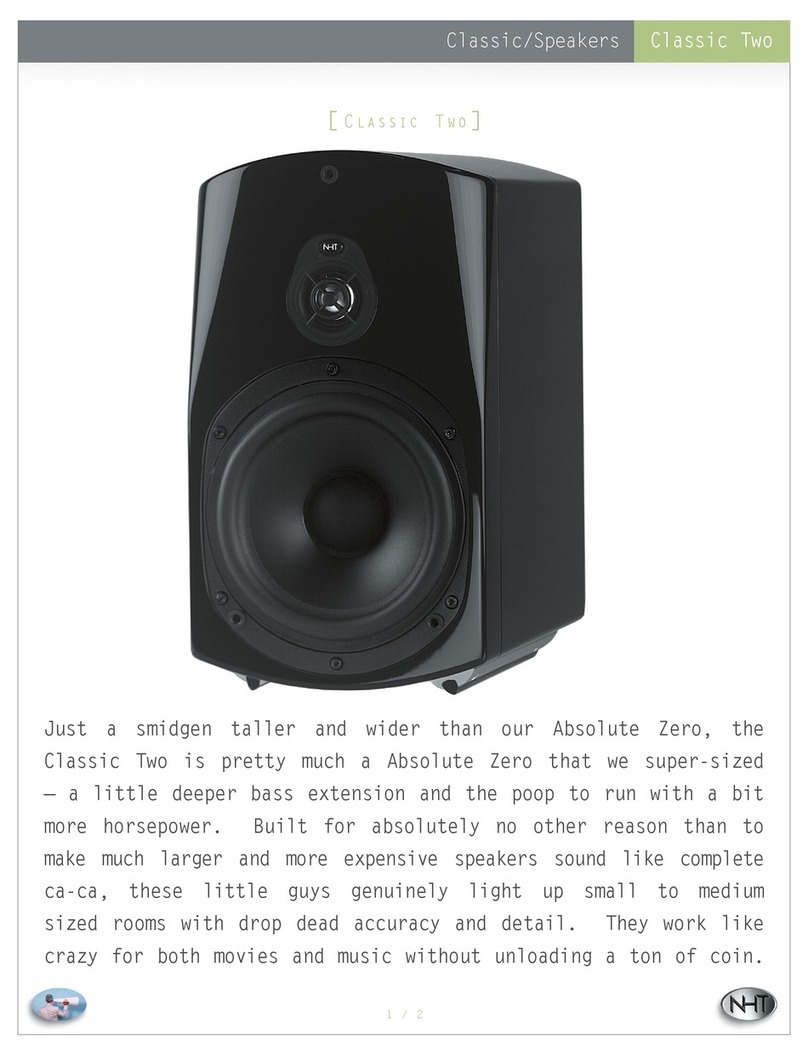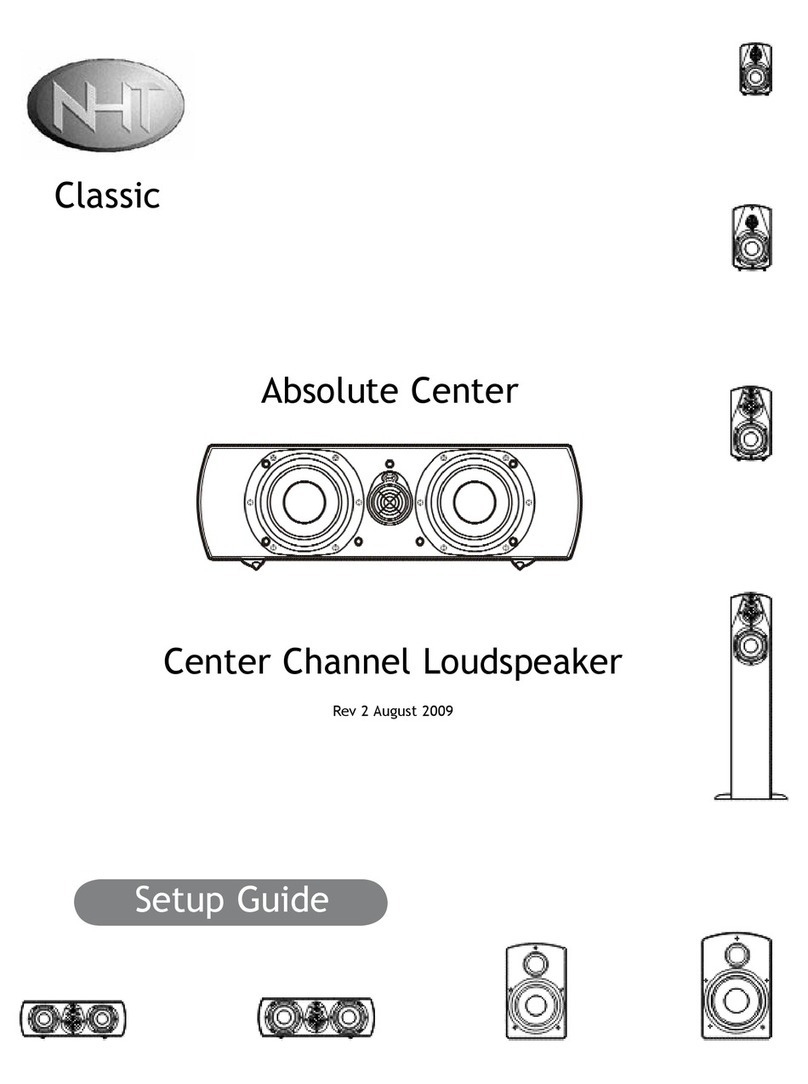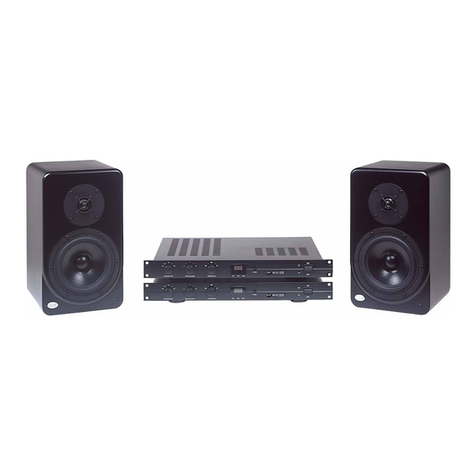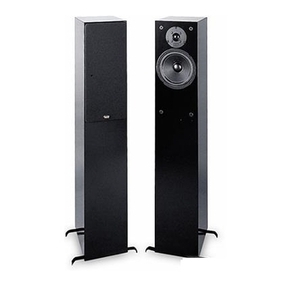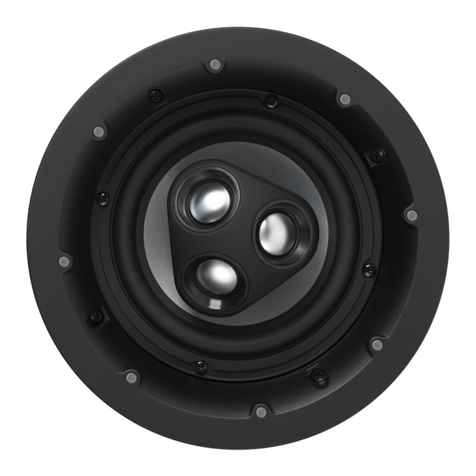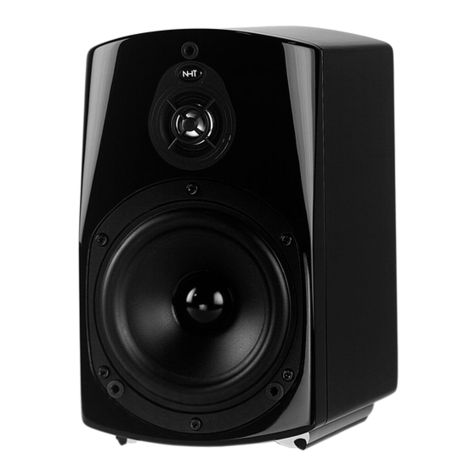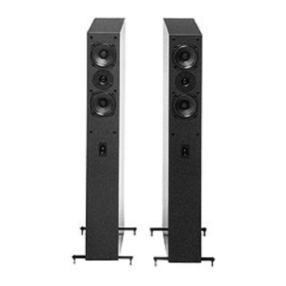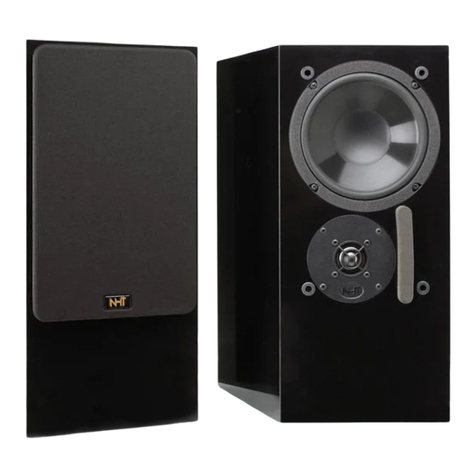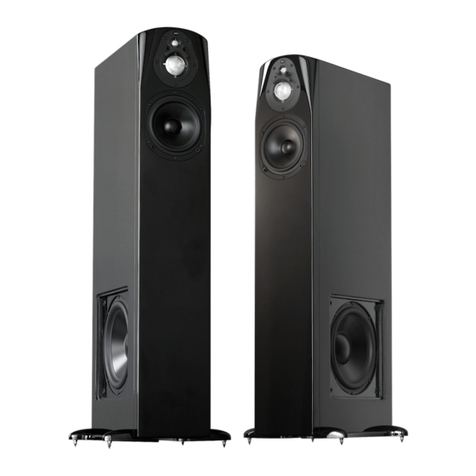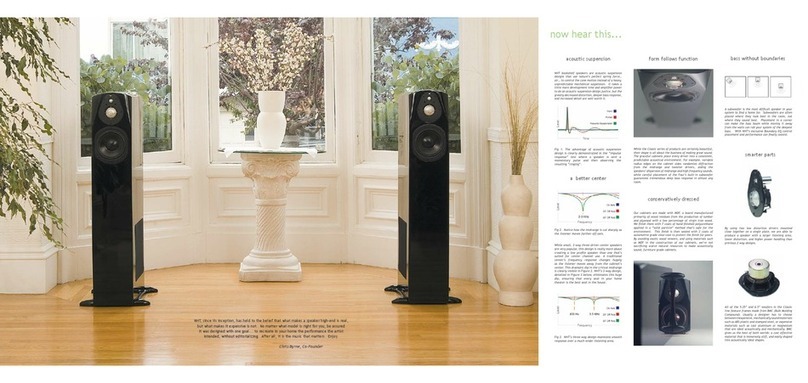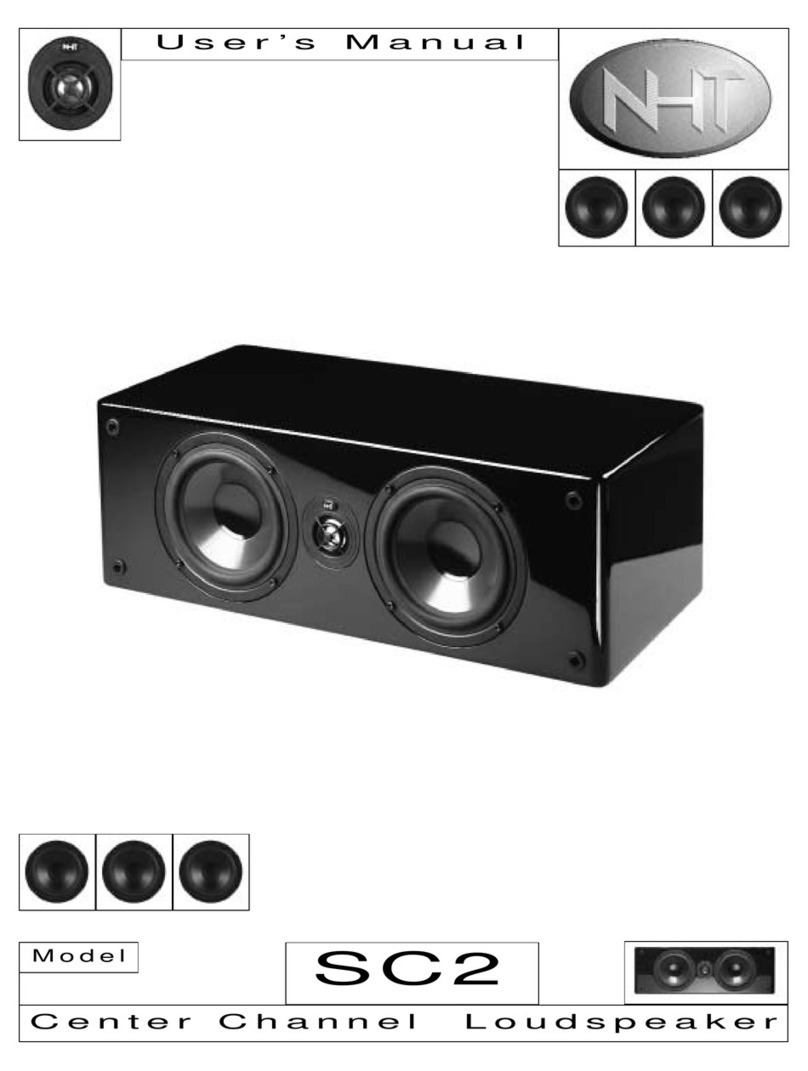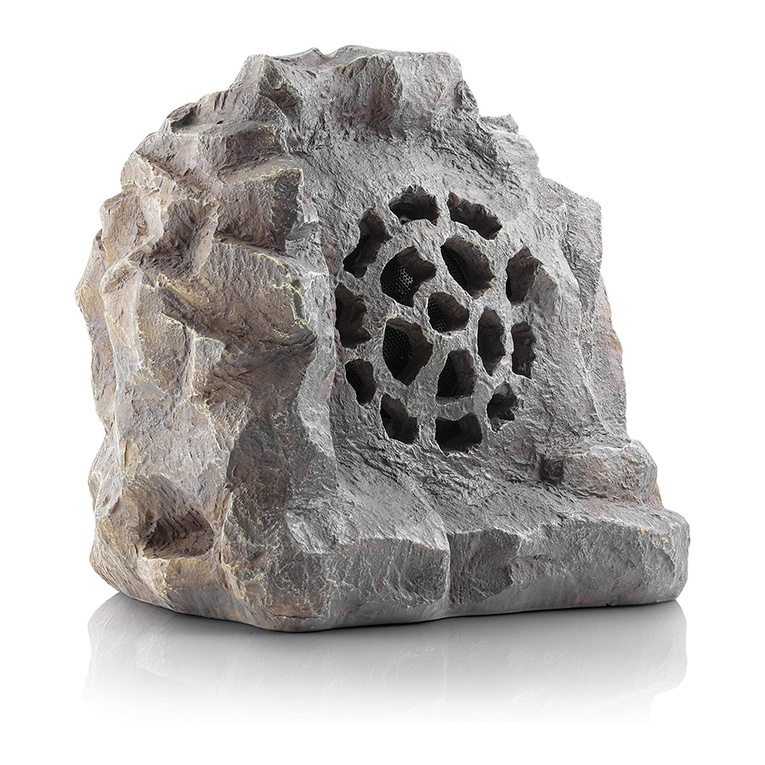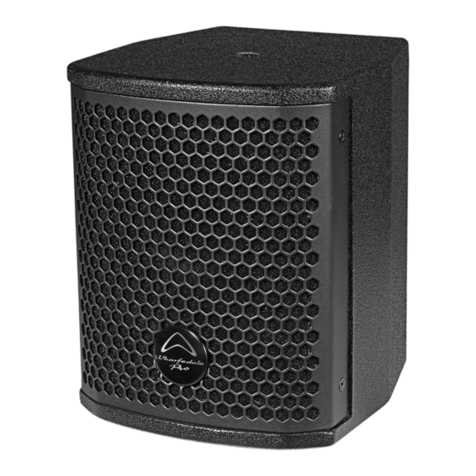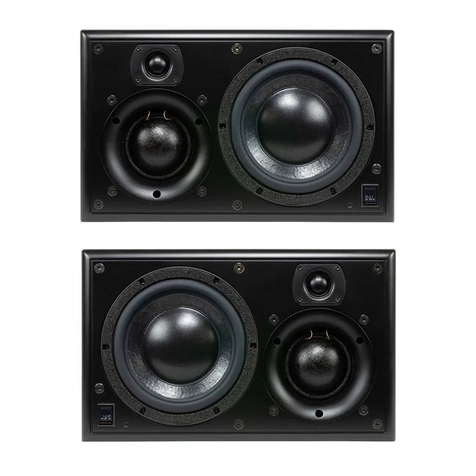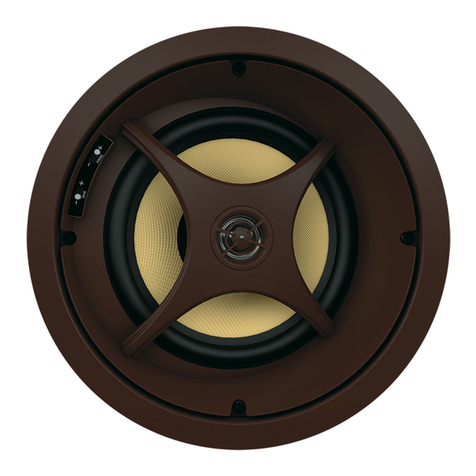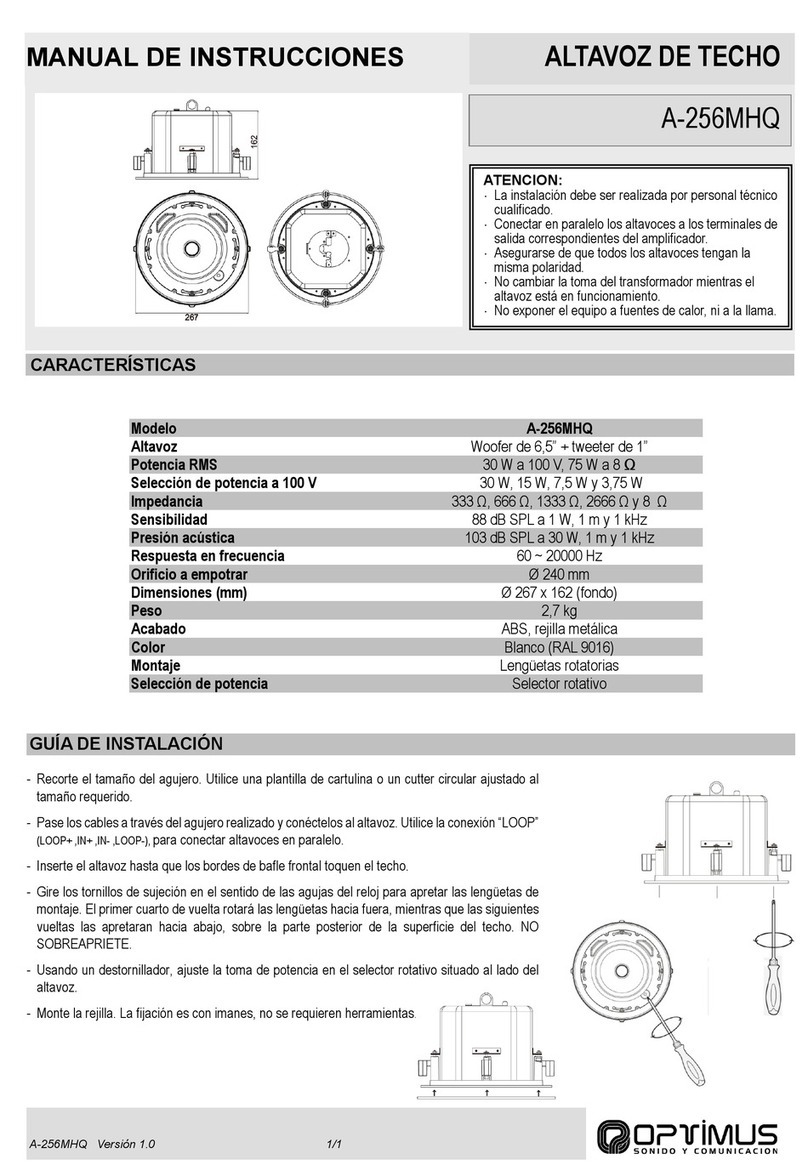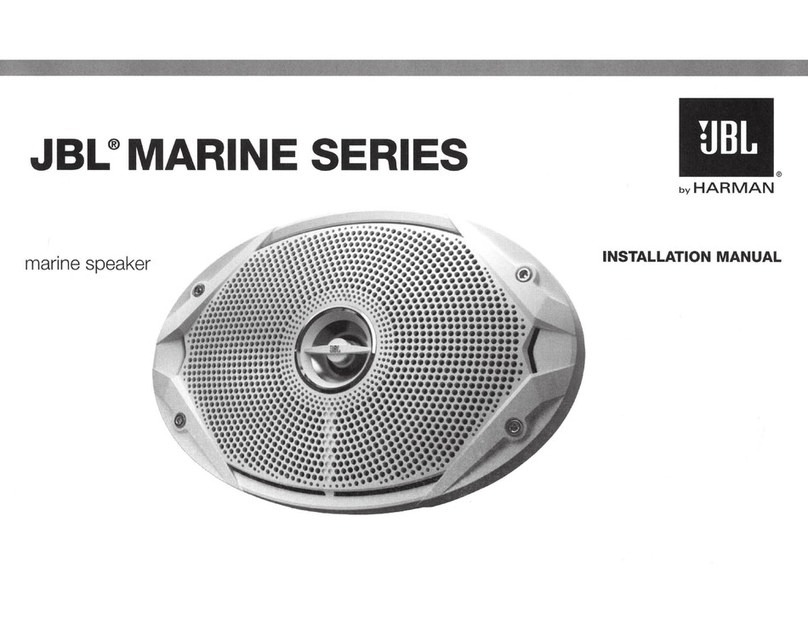NHT iC4-ARC User manual

1NHT
iC4 ARC
In-Ceiling Loudspeaker Installation Guide
In-Ceiling Loudspeaker
Installation Guide
Now Hear This.
Table of contents
1) Introduction
2) Placement
3) Wiring
4) Getting Wired
5) Drill with Caution!
6) Installation: New Construction (ceilings not installed – you see ceiling joists when you look up)
7) Installation: Existing Construction (retrofitting finished ceilings)
8) Painting
9) In Use
10) Optimizing Sonic Performance
11) Maintenance
12) Service & Support & Troubleshooting
13) Professional Specifications

2NHT
iC4 ARC
In-Ceiling Loudspeaker Installation Guide
Speaker Assembly
Metal Grille
Cardboard Cutout
Template
IC4 Cutout
Template
261,5
Introduction
We’re glad you chose NHT in-ceiling loudspeakers. We know you won’t be disappointed. Please take a few minutes to read this entire
Installation Guide prior to installing your new speakers. The information provided will help you to obtain maximum performance from
your audio system. If you have questions or need assistance at any time before, after or during the installation or operation of your new
speakers we are here to help.
Our telephone number is: 707-747-0122
Our web address www.nhthifi.com
What’s In The Box?
(1) Speaker assembly
(1) Metal grill
(1) Cardboard Cutout Template
Before we start, please, consider hiring a pro installer to do this while you go fishing with some old friends.
Cutting holes in ceilings and walls and installing heavy objects above you and your Loved Ones heads is serious business. There are also
numerous decisions concerning wiring, control systems, methods, and best practices only a professional installer will have knowledge
of. Please consult a professional to install this speaker.
Find an Installer near you by visiting www.nhthifi.com - navigate to the Where to Buy section or visit www.cedia.org to find a CEDIA
installation professional.
One last word of advice - It is up to you to insure that the installer you choose (NHT referred or not) possesses sufficient skills, proper
tools, and knowledge of local fire and building codes, and has a familiarity with the structure of the building (especially wall and/or ceil-
ing materials, layouts, electrical and plumbing lines, etc.).
With the above said, we know there are capable do-it-yourselfers. If you are one of them and want to install the speaker on your own
or with the help of an expert friend, read on. If you have questions or need assistance at any time before, during or after the installation
or about the operation of you new speakers, we’re here to help. Finally, like our fathers told us, measure twice and cut once.
First Paint Warning: NHT recommends that you use a capable, professional painter only to paint this speaker grill (if necessary to per-
fectly match the wall or ceiling). Latex paint will definitely clog the micro-perforated grill holes and constrict the speaker’s performance
capability. Contact us if when you need a new grill cover because yours is plugged up with paint. Unfortunately they are not free.

3NHT
iC4 ARC
In-Ceiling Loudspeaker Installation Guide
Placement
NHT
ARC
series of in-ceiling speakers are designed for installation in sheetrock, plaster and lath, wood and material combination ceil-
ings up to 2 1/4” thick almost always between standard wood joists. Their moisture resistant drive units, ARC frames and stainless steel
hardware allow them to be installed in moisture prone interiors and protected exterior environments like bathrooms, indoor swimming
pool rooms, covered porches, sauna rooms and under eave structures. Exposed outdoor use is not recommended. We make really great
specific “All-Weather” Outdoor speakers for this application.
Spend some time considering placement prior to installing the speakers. Once they are installed, they are more or less permanent, so
the locations should be selected carefully. When possible, locate the speakers at least 3 feet from adjacent sidewalls and at least 2 feet
from front or rear walls to allow them to radiate over the widest possible area. The speakers must be mounted on a dead flat surface to
ensure a good seal between the baffle and the ceiling because the speaker’s frame is rigid and will not flex! For the best stereo effect,
position the speakers so that they are equidistant from the most likely listening area. If the NHT in-ceiling speakers are going to serve
as rear (surround or back) channels in a home theater system, make sure to install them behind the listeners for best results. For best
results don’t mount the speakers directly over listeners heads. Position the NHT in-ceiling speakers 15˚ to 60˚ off-axis from the listen-
ing position. If you wish to get an idea how they will look, try taping the supplied cutout templates to the ceiling or print to scale one
of the grill images from our website full-size and tape it to the ceiling (maybe Kinko’s will do this for you). For more information about
home theater speaker placement, try Dolby Labs website at: www.dolby.com/us/en/consumer/setup/connection-guide/home-theater-
speaker-guide/index.html
Wiring (Retrofit Installations or New Construction)
How you wire is an important subject. If you are just wiring for 2 or 4 speakers for the surround and/or back channels of a home theater
system within the same room, it a fairly simple wiring task. Be sure to always leave yourself some extra length on the ends for working
room and terminate the speaker wires to wall plates when possible (leave yourself some extra wire to work with and stuff the excess
in the wall). All this will make your life easier. Don’t nail the wire down in place unless building codes require it - you may want to pull
additional or different cables later, if you must, use large staples to “guide” the wire. At this point you once again may consider hiring
a professional installer and have a few beers with your friends instead.
Multi-room audio, where you will use multiple pairs of speakers in different rooms, is a completely different wiring situation and the
methods for doing so are too numerous to cover here. Consider what device you will amplify them with, if you will have local controls
to wire to, if you need to pull control cables like CAT6, or will the speaker wires home run to the head-end? Lots of questions need
answers beforehand. Home runs to a single location are the safest but controlling the volume remotely in a room will then require a
wireless command and control system that are typically pricy. If all this sounds foreign to you, stop everything now and consult a pro-
fessional to learn more about your options and at least consider having a pro wire your house for the command and control system you
decide to use.

4NHT
iC4 ARC
In-Ceiling Loudspeaker Installation Guide
iCB8 Mounting Bracket Aluminum Mounting Wings Screws
Getting Wired
Proper loudspeaker wiring methods and type and quality of wire are essential to good sound. At a minimum, 16 AWG 2-conductor
speaker wire is recommended for runs up to 50 feet, 14AWG for longer runs, 12AWG for really-really long runs. When permanently in-
stalling wire inside walls, be sure to use wire that is rated for in-wall use and has special jacketing for fire prevention. In the U.S., some
of the U.L. standards are CL-2, CL-3 and CM wire, and in Canada the CSA standard is FT4 wire. The wire should be run in accordance
with National Electrical Code best practices to meet any applicable local or national building codes. Be forewarned, MDU, high-rise, com-
mercial and educational buildings have additional requirements and restrictions. For best results, avoid running speaker wire near AC
wire, as it may induce noise in the audio signal. It’s a good idea to run the speaker wire after the AC wiring has already been completed,
so that you can route the speaker wire away from AC lines or cross at 90˚. If speaker wires and AC wiring must run parallel, install the
speaker wire within a steel conduit or use shielded speaker cable. Note that low voltage wiring (doorbell, intercom, telephone, security,
etc.) can also induce hum.
Drill with Caution!
Remember, these are only suggestions. There are building codes and best practices to be followed – be sure you are familiar with them.
When drilling holes through wall studs or ceiling joists, watch your fingers, use a drill bit that is (sharp) wider than the speaker cable that
will be routed (pulled) through them. Always drill through the center of the stud or joist. If the hole must be drilled within one inch of the
edge of a wall stud, add a nail plate to the drywall side to protect the wire from possible nails and screws put in the wall later. Line up
the holes in the studs or joists as you go, so that pulling the wire through them will be easier. Maybe you consider hiring a professional
installer and see a blockbuster at the local multi-plex with some old friends instead.
Installation: New Construction (ceilings not installed – you see ceiling joists when you look up)
Installation in new construction is a three-step process. (1) Install the appropriate pre-construction brackets in the chosen locations
according to your well though-out plan. (2) Run your speakers wires to these locations according to your well though-out wiring plan.
(3) Install the speakers after the ceiling and trim is installed and painted but just before the carpet or flooring is installed.
The iCB8 kit is the pre-construction bracket you’ll use for the iC4-ARC speakers. Each box will contain a mounting kit for one speaker,
which includes:
(1) iCB8 Mounting Bracket
(2) Aluminum Mounting Wings
(4) 5 x 50mm flathead wood/metal screws

5NHT
iC4 ARC
In-Ceiling Loudspeaker Installation Guide
Tools You’ll Need:
Pencil
#2 Philips screwdriver
Tape measure
Utility knife
Keyhole saw, jigsaw or rotary saw
Safety goggles
Dust mask
Protective gloves
A ladder
Electric drill with #2 Philips bit
Band-aids
Performance tip: Consider building a box using plywood behind the speaker. We offer a technical document (Tech Docs) on the nhthifi.
com website recommending the optimal internal volume and how much insulation to place in the box by speaker model. This will help
isolate the speaker sound from bleeding into adjacent rooms, improve bass response, tightness, increase power handling and lower
distortion. Build it solid, use screws and construction adhesive and caulking to air seal it (your box) and insure it will not vibrate, rattle,
fall apart or come loose. Make sure it is supported by the ceiling joists, not the sheetrock!
1. Once you’ve selected the desired location(s) for the speakers, begin installing the iCB6 pre-construction bracket(s) between adjacent
ceiling joists. First attach the mounting wings to the bracket by inserting them into the locking plastic tabs in the side of the bracket
(fig.1).
2. The wings feature progressively scored sections (1”, 1”, 2”, 2”, 2”, 3”, 3”) with screw holes spaced in one-inch increments to help
you align the bracket. The iCB6 pre-construction bracket has NHT logos on one side - this side should be oriented away from the dry-
wall – towards the sky. Attach the wings to the joists using the 50mm flathead screws, use two screws for each wing. Cut off the extra
portion of the wing. (fig.2).
Installation: New Construction Continued....
Fig. 1

6NHT
iC4 ARC
In-Ceiling Loudspeaker Installation Guide
3. Complete the pre-wiring to the speaker brackets before the drywall goes up. Leave an extra few feet of speaker wire on each end to
make your life easier later. Coil the excess and tack it carefully to an adjacent ceiling joist for easy retrieval during speaker installation.
You can be clever here.
4. During the drywall installation, cut a hole in the drywall so it butts up to the protruding lip of the mounting bracket, as you would cut
out for a ceiling light can. (Once installed, the lip of the speaker frame will extend about ½ inch beyond the perimeter of the bracket lip
to hide minor imperfections in the cutout.) (fig.3).
5. After the ceiling trim work is installed and the painting is complete, but just before the carpet or flooring is installed install the speaker
by first connecting the speaker wire to the spring posts on the back of the speaker assembly, making sure to observe correct polarity
– red (+), black (-).
Fig. 2
Fig. 3
Installation: New Construction Continued....

7NHT
iC4 ARC
In-Ceiling Loudspeaker Installation Guide
Fig. 4
Installation: New Construction Continued....
6. The speaker assembly is then inserted into the hole in the bracket and attaches to the bracket and ceiling drywall via four plastic,
spring-loaded mounting clamps (dog-legs) on the back of the speaker assembly that will swivel out 45˚ and lower to “sandwich” the
drywall (and mounting bracket) when you start to tighten the 4 mounting screws (fig.4). Begin this phase by being sure the dog-legs
are rotated sideways (like the speaker came packed) so that the body of the speaker assembly can slide through the mounting bracket.
Exercise caution not to damage the drivers themselves.
Note: it’s ok to let the fiberglass insulation lay on the back of the speaker.
7. Begin to tighten the screws that at first will rotate the dog-legs out 45˚ and then they will start to move downwards to clamp the
ceiling (and bracket). Tighten the screws carefully but snugly, making sure to not over tighten, as this may compromise the fit of the
speaker assembly. The use of power screwdrivers is not recommended but if you must, set the toque ratchet setting at its least resis-
tive position and the speed very low. The speaker frame lip should rest flush and seal against the ceiling. The spring loaded mounting
clamps provide tension once installed.
8. Once all the screws are snug and speaker secure, install the grill. It uses magnets to attach to the speaker. You will notice a gauzy-
white cloth on the speaker side of the grill. It’s called “scrim cloth” and helps hide the speaker’s silhouette from showing through the
grill. Do not remove this scrim under penalty of law! Respect the scrim.

8NHT
iC4 ARC
In-Ceiling Loudspeaker Installation Guide
Installation: Existing Construction (retrofitting finished ceilings)
This multi-step process begins by identifying a location in your ceiling for the speaker (always keeping a plan B in mind). Somehow you’ll
need to get speaker wire to that spot. Using a stud-finder or something you will make sure there are no obstructions behind your in-
tended speaker location. Using the enclosed cutout template you will mark the hole and cut a clean hole using a rotary cutter, sheetrock
or keyhole saw. After you have found and connected the speaker wire you will mount the speaker in the hole and snap on the magnetic
grill. It’s usually not as easy as this sounds and you should once again consider hiring a pro installer.
Warning: Exercise caution when drilling into existing ceilings. Do not drill through electrical wires, pipes, drains, conduits, heating or
air conditioning ducts or structural wood or metal support members. If you feel resistance while drilling, you should stop immediately.
Do not install the speaker into a drop ceiling (T-Bar) or soft ceiling without a proper backing board to spread the load, as this type of
construction will not support its weight.
You will not need the iCB6 pre-construction bracket nor will you be able to install it if you wanted to. The speaker is designed to mount
securely without it (assuming you do everything right).
Tools You’ll Need:
#2 Philips screwdriver
Pencil
Tape measure
Utility knife or keyhole saw
Safety goggles
Dust mask
Protective gloves
A ladder
Electric drill with #2 Philips bit
Band-aids
1. Using a “stud finder” or the “knocking” method, locate the ceiling joists in the ceiling area where you wish to mount the speaker. The
speaker will be mounted between adjacent joists, no closer than two inches from either joist.
2. Determine that there are no obstructions above the desired cutout area. This may be accomplished by drilling a hole in the center of
the cutout area and using an “L” shaped piece of metal (like a bent coat hanger wire) to “feel around” above the ceiling. If you discover
an obstruction, fill the hole with patching compound and try another location (plan B).

9NHT
iC4 ARC
In-Ceiling Loudspeaker Installation Guide
Installation: Existing Construction Continued....
3. If no obstructions are found above the ceiling, use the supplied cutout template and a pencil to draw an outline of the area to be cut
out. Make sure you are using the right template. Begin by drilling a hole on the inside of the circle with a 1/4” bit, then cut the hole with
a keyhole saw or use a rotary cutter (fig.7). If the ceiling is painted, use the utility knife to score the paint so the sheetrock paper or
paint does not peel when you cut. Once installed, the speaker frame lip will extend about 1/2 inch beyond the perimeter of the cutout
to hide minor cutting imperfections.
4. If the ceiling is constructed of lath and plaster, outline the penciled circle with masking tape to help prevent plaster cracking, drill a
1/4” hole, and use a jig saw with a new blade or rotary saw to cut through the plaster lath. A saber saw with a metal cutting blade can
be used however this saw will vibrate plaster off the ceiling and is easy to loose control of. Save yourself the headache and buy a good
rotary cutter. Always be prepared to patch the plaster.
5. Locate the speaker wire, strip the ends ½” and connect the speaker wire to the spring posts on the back of the speaker, making sure
to observe correct polarity - red (+), black (-).
7. The speaker assembly mounts to the existing ceiling via four plastic, spring-loaded mounting clamps (dog-legs) on the back of the
speaker assembly that will swivel out 45˚ and lower to “sandwich” the speaker assembly in place between its protruding outer frame
and the rear surface of the drywall. Begin this phase by being sure the dog-legs are rotated sideways (like the speaker came packed) so
that the body of the speaker assembly can slide through the mounting bracket. Exercise caution not to damage the drivers themselves.
(fig. 4).
8. Tighten the screws snugly, making sure not to over tighten, as this may compromise the fit of the speaker assembly. The use of power
screwdrivers is not recommended. The gasket on the back the speaker assembly lip reduces unwanted vibrations against the drywall
and will compress slightly to allow the speaker assembly lip to rest flush and seal against the ceiling.
Painting
Don’t. But if you must to keep the homeowner or decorator happy, take the grill to a professional painter. Bring a sample of the color
you want with you along with a box of chocolate for the painter. High-end custom automotive painting shops can match the color and
paint the grill without plugging up the 1000 grill holes. We have extra grills available, for a charge, if you do not heed our warning and
try to paint the grill yourself with latex paint.
In Use
The NHT in-ceiling speakers are designed to handle a wide range of listening levels, but every speaker has limits. It is important to use
common sense and listen for signs of possible distress from the speakers – here are some pointers to remember:
- Noticeable distortion or harsh breakup is an indication that the amplifier or your speakers are running beyond their capacity, and the

10 NHT
iC4 ARC
In-Ceiling Loudspeaker Installation Guide
volume should be decreased ASAP.
- Speaker damage most often occurs from sustained high volume levels, not from transient sounds or brief musical peaks.
- Excessive boosting of bass, treble or equalizer controls can worsen the problem, and is not recommended.
- Having more power is always better than having less. Underpowered amplifiers are most often the cause of speaker damage.
- If you tend to listen at higher volume levels, get a powerful amplifier because they are less likely to run out of power.
- Proper wiring of the speakers is critical to good sound - speaker wires have some sort of marking along one or both conductors to help
you make the correct connections.
- Weak bass and the lack of a well-defined stereo image indicate incorrect speaker phase (the + and – are reversed on one speaker)
Optimizing Sonic Performance
Bass response is smoothest when the speaker is mounted into a rigid ceiling that flexes very little. For improved performance, during
framing, add cross-braces horizontally roughly one and a half feet to either side of the speaker location. Use adhesive caulk and extra
screws when attaching the drywall to the joists around the speaker. Additionally, once the speaker cutout has been made in the drywall,
add a strip of a high-quality non-hardening construction adhesive type caulk where the drywall meets the joists and cross-braces. Also
for more controlled bass response, add (code-approved & fire resistant) insulation to the ceiling cavity around and behind the speaker to
provide acoustic damping. Be sure to add the same amount of insulation to each speaker in the same room to ensure consistent sound.
Use R-12 or R-19 fiberglass insulation, and be sure to wear protective gloves and a breathing mask to avoid contact and inhalation of
the fibers. If the insulation is paper or foil faced, position the paper or foil side away from the speaker. If the new or existing insulation
is the “loose” blown-in type, place a thin sheet of fiberglass over the top of the speaker to keep out small debris.
Maintenance
Do not expose the speakers to direct sunlight or excessively high temperatures.
Do not attempt to clean the actual drivers (speakers) themselves.
You may clean the grill after removal with a citrus-based cleaner to cut a greasy film otherwise a mild detergent will clean the speaker
up nicely. Avoid harsh cleaners. Let dry completely.

11 NHT
iC4 ARC
In-Ceiling Loudspeaker Installation Guide
REV 4313
Service & Support & Troubleshooting
Contact the NHT Authorized Reseller who sold you the products or,
Contact NHT by telephone go online at www.nhthifi.com and navigate to the Service Center area for more information.
Professional Specifications
Average Impedance 8Ω
Recommended Power 20-150W
Max RMS Power Handling 150W
Coverage to 60˚off-axis
Cutout dim: 10.50” diameter (8-1/2”)
Depth behind the wall: 4.81” (4-13/16”)
Finished dim: 11”
Table of contents
Other NHT Speakers manuals
Popular Speakers manuals by other brands
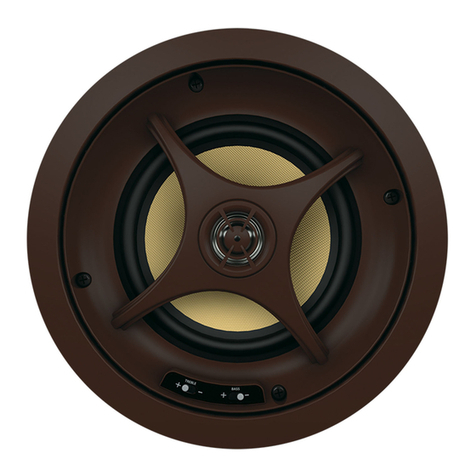
Proficient Audio Systems
Proficient Audio Systems Signature C895s owner's manual
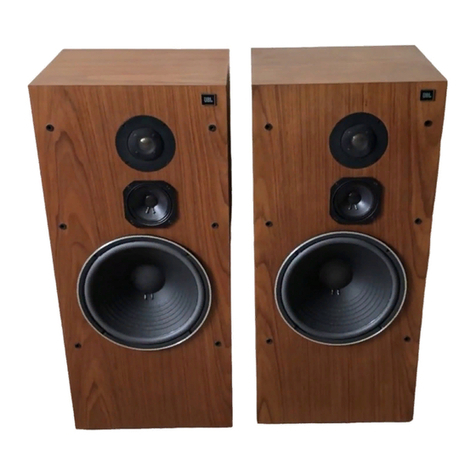
JBL
JBL L100T instruction manual
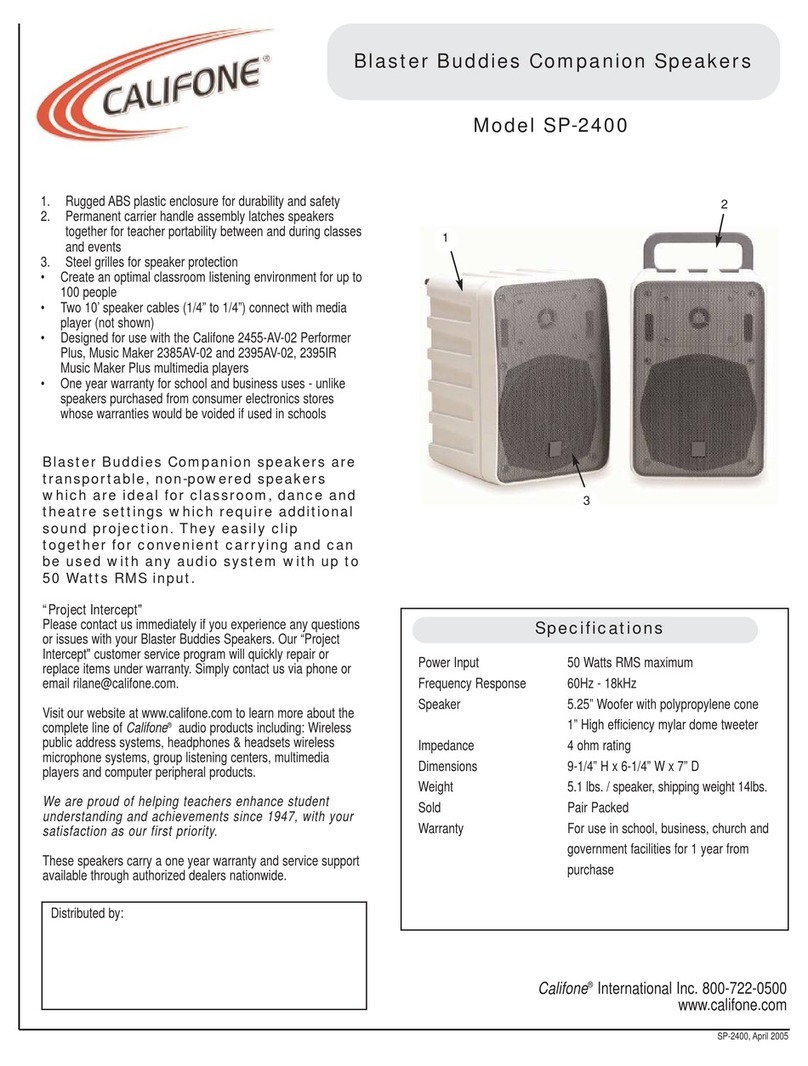
Califone
Califone Blaster Buddies SP-2400 Specifications
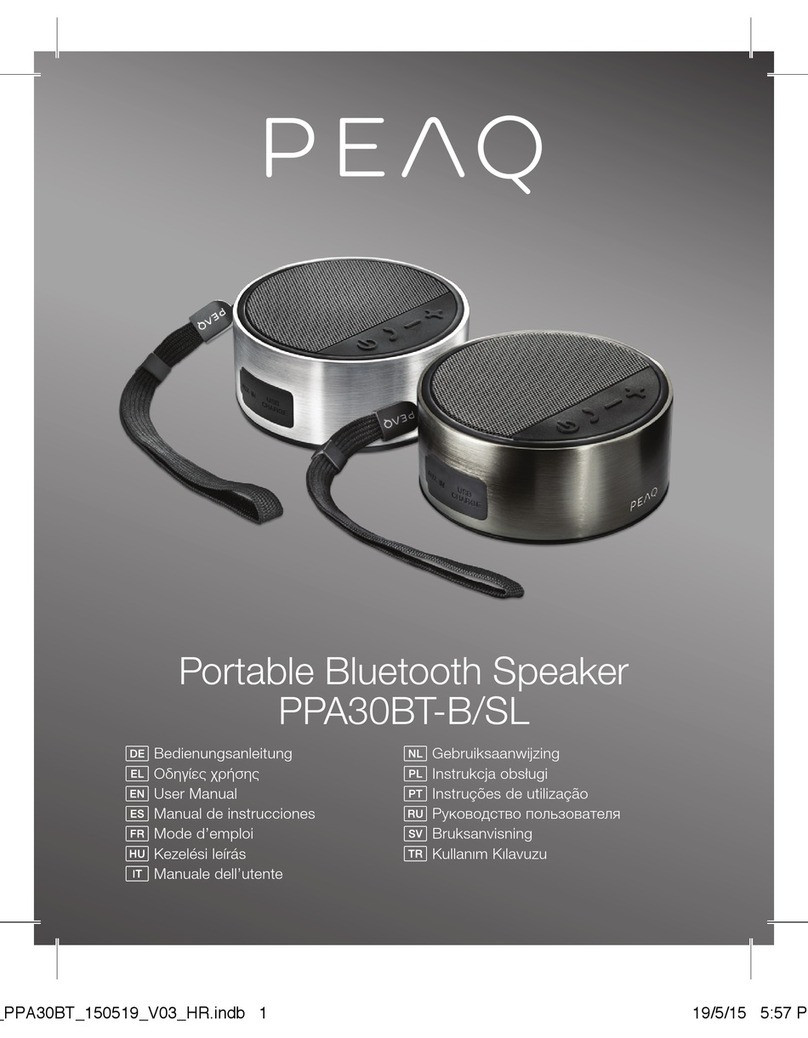
Peaq
Peaq PPA30BT-B/SL user manual
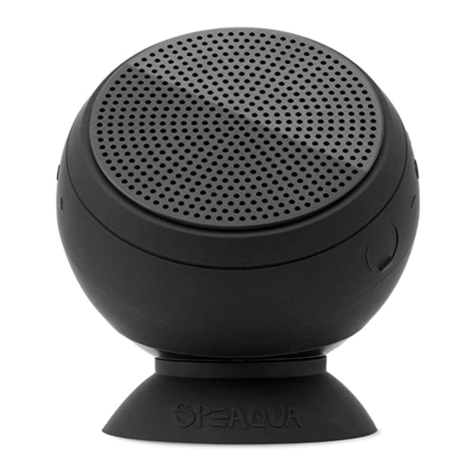
Speaqua
Speaqua Barnacle Plus user manual
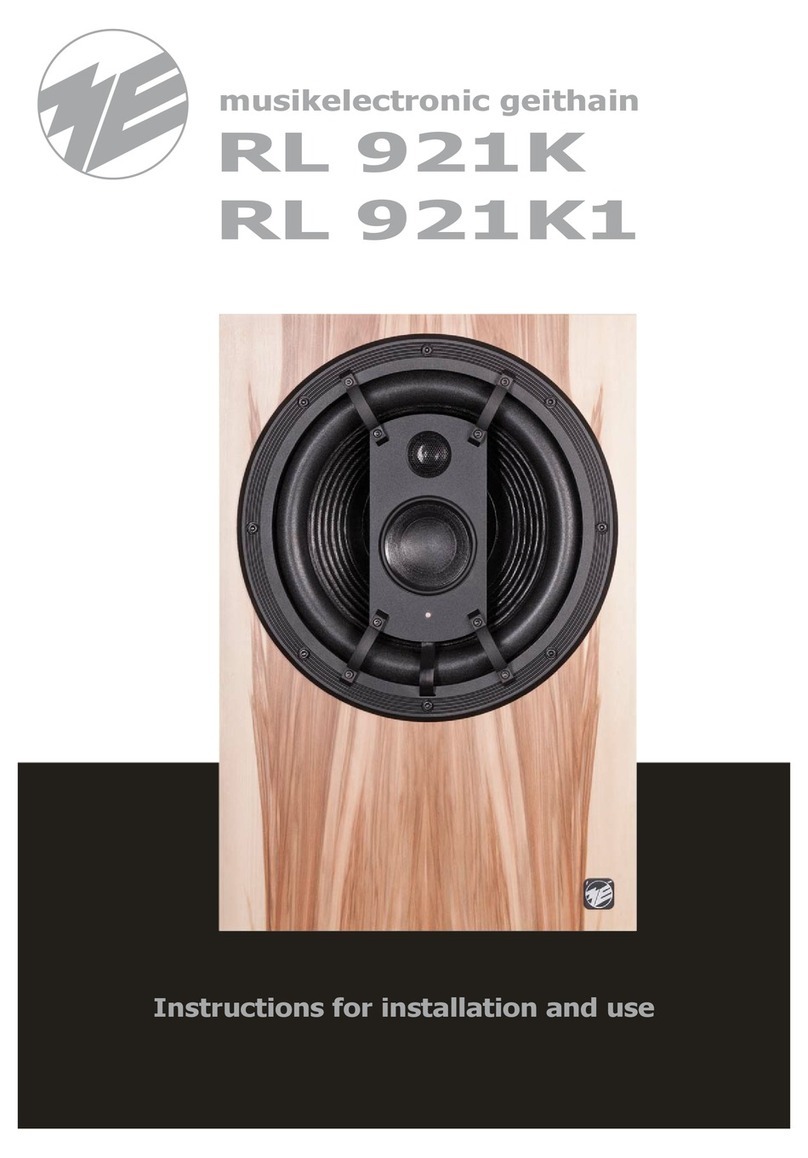
musikelectronic geithain
musikelectronic geithain RL921K1 Instructions for installation and use




